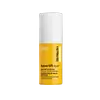What's inside
What's inside
 Key Ingredients
Key Ingredients

 Benefits
Benefits

 Concerns
Concerns

No concerns
 Ingredients Side-by-side
Ingredients Side-by-side

Water
Skin ConditioningPropylene Glycol
HumectantSodium Silicate
BufferingMagnesium Aluminum Silicate
AbsorbentQuartz
AbrasiveMyristyl Nicotinate
Skin ConditioningEuterpe Oleracea Fruit Extract
Perilla Frutescens Extract
Skin ConditioningQuercus Alba Bark Extract
AstringentChondrus Crispus Extract
Skin ConditioningSodium Hyaluronate
HumectantDipeptide Diaminobutyroyl Benzylamide Diacetate
Skin ConditioningAcetyl Hexapeptide-8
HumectantAcetyl Octapeptide-3
HumectantPentapeptide-18
Skin ConditioningPalmitoyl Tripeptide-1
Skin ConditioningPalmitoyl Tetrapeptide-7
Skin ConditioningLactobacillus Ferment
Skin ConditioningIllite
AbrasiveMontmorillonite
AbsorbentCellulose Gum
Emulsion StabilisingGlycerin
HumectantButylene Glycol
HumectantCaprylyl Glycol
EmollientCarbomer
Emulsion StabilisingPolysorbate 20
EmulsifyingSodium Dehydroacetate
PreservativeCitric Acid
BufferingChlorphenesin
AntimicrobialSorbic Acid
PreservativePotassium Sorbate
PreservativePhenoxyethanol
PreservativeEthylhexylglycerin
Skin ConditioningCI 77491
Cosmetic ColorantWater, Propylene Glycol, Sodium Silicate, Magnesium Aluminum Silicate, Quartz, Myristyl Nicotinate, Euterpe Oleracea Fruit Extract, Perilla Frutescens Extract, Quercus Alba Bark Extract, Chondrus Crispus Extract, Sodium Hyaluronate, Dipeptide Diaminobutyroyl Benzylamide Diacetate, Acetyl Hexapeptide-8, Acetyl Octapeptide-3, Pentapeptide-18, Palmitoyl Tripeptide-1, Palmitoyl Tetrapeptide-7, Lactobacillus Ferment, Illite, Montmorillonite, Cellulose Gum, Glycerin, Butylene Glycol, Caprylyl Glycol, Carbomer, Polysorbate 20, Sodium Dehydroacetate, Citric Acid, Chlorphenesin, Sorbic Acid, Potassium Sorbate, Phenoxyethanol, Ethylhexylglycerin, CI 77491
Ingredients Explained
These ingredients are found in both products.
Ingredients higher up in an ingredient list are typically present in a larger amount.
Acetyl Octapeptide-3 is a synthetic peptide also commonly known as SNAP-8. It is a lab-made peptide often marketed as a gentler, topical alternative to Botox.
It works by mimicking part of a protein involved in muscle contractions, which may help relax facial tension and reduce the appearance of fine lines (mostly around the eyes and forehead).
It’s considered a “next-gen” version of Argireline (Acetyl Hexapeptide-8), an older peptide with more research behind it that also supports collagen production.
SNAP-8 showed slightly better results than Argireline in one small manufacturer-funded study, but there’s limited independent research. Plus, most tests use concentrations higher than what’s typically found in skincare products.
This ingredient might offer a subtle smoothing effect but it won't don’t deliver the dramatic results of actual Botox injections.
Think of it more like a supporting actor in your skincare lineup.
Learn more about Acetyl Octapeptide-3Butylene Glycol (or BG) is used within cosmetic products for a few different reasons:
Overall, Butylene Glycol is a safe and well-rounded ingredient that works well with other ingredients.
Though this ingredient works well with most skin types, some people with sensitive skin may experience a reaction such as allergic rashes, closed comedones, or itchiness.
Learn more about Butylene GlycolCaprylyl Glycol is a humectant and emollient, meaning it attracts and preserves moisture.
It is a common ingredient in many products, especially those designed to hydrate skin. The primary benefits are retaining moisture, skin softening, and promoting a healthy skin barrier.
Though Caprylyl Glycol is an alcohol derived from fatty acids, it is not the kind that can dry out skin.
This ingredient is also used as a preservative to extend the life of products. It has slight antimicrobial properties.
Learn more about Caprylyl GlycolEthylhexylglycerin (we can't pronounce this either) is commonly used as a preservative and skin softener. It is derived from glyceryl.
You might see Ethylhexylglycerin often paired with other preservatives such as phenoxyethanol. Ethylhexylglycerin has been found to increase the effectiveness of these other preservatives.
Magnesium Aluminum Silicate is a type of silica. It comes from naturally occuring minerals such as silicate ores and clay.
Magnesium aluminum silicate is used for enhancing texture and as an absorbent. Due to its large molecular size, it is unable to be absorbed into the skin.
Like other types of silica, this ingredient can be used to thicken a product. As an absorbent, it may be used to absorb extra water or help prevent clumping.
Although “aluminum” in an ingredient name can raise red flags for some consumers, the form and usage context matter significantly. For typical topical applications, there is no substantial evidence of health risks - such as cancer, neurotoxicity, or systemic “aluminum overload.”
Learn more about Magnesium Aluminum SilicatePhenoxyethanol is a preservative that has germicide, antimicrobial, and aromatic properties. Studies show that phenoxyethanol can prevent microbial growth. By itself, it has a scent that is similar to that of a rose.
It's often used in formulations along with Caprylyl Glycol to preserve the shelf life of products.
We don't have a description for Sodium Silicate yet.
Water. It's the most common cosmetic ingredient of all. You'll usually see it at the top of ingredient lists, meaning that it makes up the largest part of the product.
So why is it so popular? Water most often acts as a solvent - this means that it helps dissolve other ingredients into the formulation.
You'll also recognize water as that liquid we all need to stay alive. If you see this, drink a glass of water. Stay hydrated!
Learn more about Water